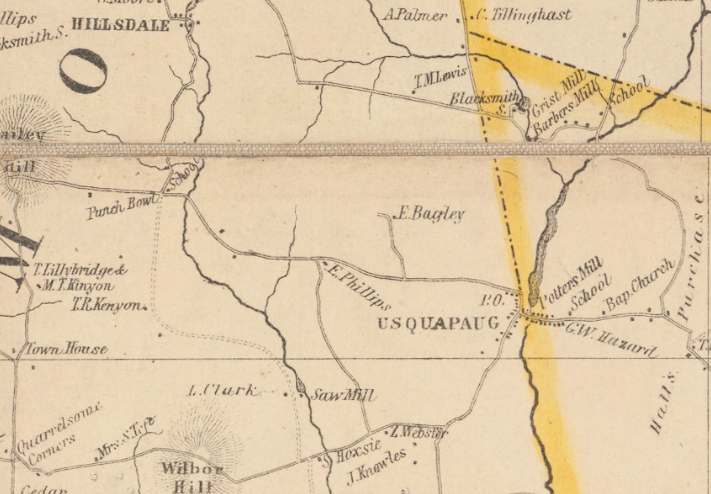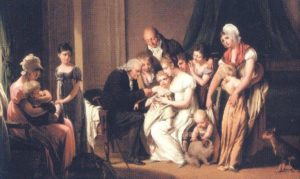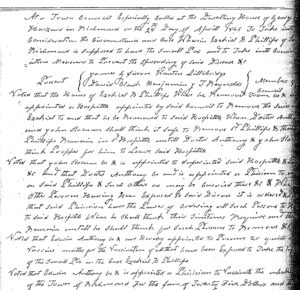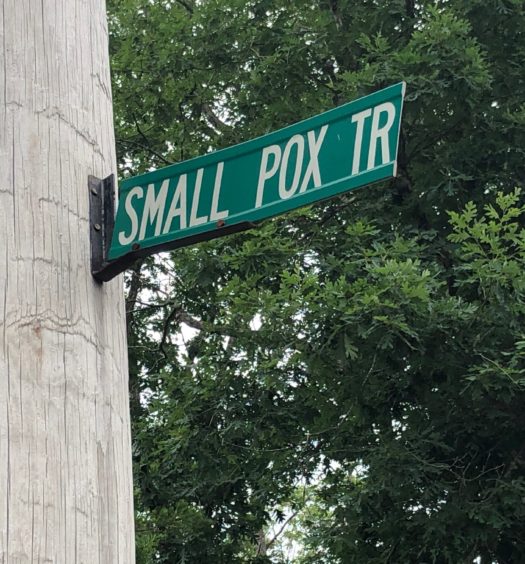While Carolyn Richard was a member of the Richmond Town Council, she was approached by a resident who complained about the name of the street where she lived—Smallpox Trail. Carolyn says, “She admonished me that where she came from— California— no street would ever be named for a disease. I didn’t waste my time explaining any of the history to her, as I figured she would neither appreciate nor comprehend it. I just suggested that she return to California and settle somewhere where the streets are just numbered. I believe she did.”
Here is the story Carolyn didn’t tell the woman from California.
On Monday, April 28, 1845, the Richmond Town Council called a special meeting at George W. Hazard’s inn at Usquepaugh to deal with an emergency: One of the Council members, Ezekiel B. Phillips, had contracted smallpox.[1]
The Town Council directed that the Phillips home become a temporary hospital and that Ezekiel be returned there— apparently he had left when he realized he was seriously ill. The Council appointed John Slocum, an Usquepaugh farmer and stone mason[2], as superintendent of the hospital and appointed Dr. Israel Anthony as the hospital’s physician. Dr. Anthony was given the authority to order anyone in town suspected of having the disease to be confined and cared for in the Phillips home.
Dr. Anthony’s only son, Edwin, had graduated from Harvard Medical School three years earlier, after having trained with his father. (Israel Anthony had trained with his own father, Jonathan, before attending the medical school at Brown University.)[3] The Council ordered Edwin to “procure 20 gills [of] vaccine matter” and to operate a public vaccination clinic for anyone in Richmond who had been exposed to the deadly disease.[4] He was directed to provide vaccinations at “five different times and places in said Town twice and to attend from the hours of ten of the clock A.M. to 4 P.M. on each day.”
Ezekiel Barber Phillips, a merchant and farmer,[5] served on the Town Council from June 1844 to June 1846. He was born in Exeter on August 2, 1793, son of Joseph Phillips and Susanna Barber.[6] In 1845 Ezekiel lived on a farm with Penelope (Woodmansee), the first of his three wives.[7] The farm, called the Webb farm after its previous owner, was on the road now known as Punchbowl Trail that runs east-west between the village of Usquepaugh and Hillsdale Road.[8]
As the licensed keeper of a “temperance tavern,” Ezekiel presumably was an upstanding citizen.[9] His last will and testament, made 9 November 1863 and proved 15 May 1865, indicates that he was a prosperous farmer and a substantial landowner. He left $1,000 to his widow and each of his children, all three of whom were minors at the time of his death. To his son he bequeathed the Webb farm, the Benjamin Barber farm, the Ezekiel James lot, the Tindall lot, and parcels he bought from Sanford Sherman, Arnold Nye, and Samuel Hoxsie, as well as a silver watch, household furnishings (including a framed portrait of George Washington), and all the books that had belonged to the boy’s mother. Ezekiel’s daughters received the Tefft Farm and two adjacent lots he had purchased from John A. Barber and members of the Tefft family. As co-executors of his estate he named his wife Martha and Halsey Perry Clarke,[10] a prominent Richmond resident who was a director of the Richmond Bank, a vice president of the Washington County Agricultural Society, and town clerk for more than fifty years.[11]
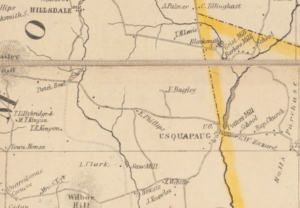
Detail from Map of the State of Rhode Island, by Henry F. Walling, showing the location of the Phillips house (Harvard University Map Collection)
Although most people alive in the 1840s would not have been old enough to remember, smallpox was a scourge throughout the 18th century. A terrible smallpox outbreak spread across North America between 1775 and 1782, during the American Revolutionary War. In the 19th century, while not as widespread as in the previous century, the disease was still regarded with fear and dread, and it continued to claim victims.
A Little Compton resident named Enos Gifford, age 34, died of smallpox on February 4, 1840.[12] The Providence Evening Chronicle reported many cases of smallpox in various parts of the city in April of 1842.[13] On June 3, 1845, Thomas Goddard was elected Overseer of Smallpox for Newport.[14] On August 9, 1845, the Newport Mercury advised its readers that there presently were five cases of smallpox in Fall River.[15] Smallpox was reported to be prevalent in Plymouth, Massachusetts, in October of 1845, with thirty cases reported and one death.[16] In August of 1847, a case of smallpox was reported in New Bedford in the northern part of the city, near Beetle’s spar yard.[17] In January of 1849, Roderick Gardner of Bozrah, Connecticut, “while laboring under a fit of partial derangement, threw a large quantity of [gun]powder into the fireplace in his house” and died as a result of injuries suffered in the explosion. He said he had been trying to “drive the smallpox from the neighborhood.”[18]
When the Richmond Town Council met next, on May 12, the Council granted John Slocum’s request to be discharged from his duties as superintendent of the temporary hospital. Ezekiel, who apparently had recovered sufficiently, was appointed to care for his family under Dr. Anthony’s direction. It is not certain who those family members were, other than his wife, or whether they survived the smallpox. The 1840 federal census enumerates the members of the household as Ezekiel, his wife, a daughter between 5 and 9 years old, and a female between 60 and 69 years old.[19] Neither the daughter nor the elderly woman were enumerated with Ezekiel in the 1850 census.[20]. No record of the birth or death of a daughter of Ezekiel and Penelope could be found.
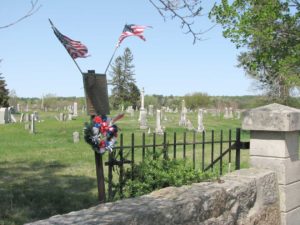
Queens River Baptist Church Cemetery, which contains the graves of Dr. Edwin Anthony and members of his family (FindAGrave.com)
Penelope Phillips died on May 22, 1847.[21] On October 17 of the same year, Ezekiel married Bathsheba W. Briggs, aged 34.[22] Their son, Ezekiel W. Phillips, was born in 1849.[23] Bathsheba died in 1854,[24] and the following year, Ezekiel married Martha M. (Tanner) Sanders, a widow from Hopkinton.[25] They had two daughters, the first named for Ezekiel’s first and second wives and the second named for his third wife.[26] Ezekiel died in 1865 at the age of 71 and was buried in the family burial ground with his first two wives.[27]
Ezekiel Phillips’s house was at the southeast corner of Punchbowl Trail and the road now known as Smallpox Trail. Smallpox Trail, which is just under a mile long, connects Punchbowl Trail to what is now Route 138. It almost certainly got its name as a result of the notoriety attached to it in 1845.
The Richmond Historical Society website, speculating on the origin of the street name, notes that “the road appears on an 1812 map.” [28] This may suggest to some that Smallpox Trail was labeled “Smallpox Trail” on an 1812 map. But anyone familiar with 18th and 19th century maps of rural areas knows that landmarks such as ponds and hills were sometimes identified, but streets were not, probably because many had no formal name. Smallpox Trail is not even identified by that name on the Richmond map in the 1870 D. G. Beers & Co Rhode Island atlas. There is no reason to think Smallpox Trail was known by that name before 1845.
Also posted on the website is a Historical Society member’s description of a 1975 “Field Trip to Smallpox Corners” to see the remains of the “smallpox corners house.” That document says that according to legend, “All members of this family were stricken with the smallpox, and all died there. When the last member perished, the house was burned to destroy the scourge.”[29]
The legend of the “smallpox corners house” is easily debunked. Ezekiel and his wife survived the smallpox outbreak in 1845. Were there two smallpox quarantine houses at this corner? That would have been quite a coincidence. A house would not have been burned to the ground just because it sheltered smallpox victims. The clothing and bedding would have been burned, not the house itself.
Dr. Edwin Anthony, the young doctor who administered vaccinations throughout Richmond, survived the smallpox outbreak despite having to administer vaccine to every Richmond resident who had been exposed. In 1853, his father sold him a plot of land next to the Queen’s River in the village of Usquepaugh, and he built a home for his family.[30] The house, at 72 Old Usquepaugh Road, remained in the Anthony family until 1921 and is still standing. Dr. Anthony died on February 20, 1869 at the age of 47 and is buried with his parents, his wife, and three of his four children in the cemetery next to the Queens River Baptist Church in Usquepaugh.[31] [The author would like to thank Kristen Chambers and Carolyn Richard of the Richmond Historical Society for their assistance with research for this article]
[Banner image: Detail from Map of the State of Rhode Island, by Henry F. Walling, showing the location of the Phillips house (Harvard University Map Collection)]
Footnotes
[1] Richmond, Rhode Island Town Council records, 7:138-139 (April 28, 1845 and May 12 ,1845). [2] Charles E. Slocum, A Short History of the Slocums, Slocumbs, and Slocombs of America (Syracuse, N.Y.: self-published, 1882), 290-291. [3] J. R. Cole, History of Washington and Kent Counties, Rhode Island (New York, N.Y.: W. W. Preston & Co., 1889), 200; Charles L. Anthony, Genealogy of the Anthony Family from 1495 to 1904 (Sterling, Ill.: self-published, 1904), 105-107. [4] Vaccination within a week of exposure could lessen the severity of the disease. “Smallpox,” Wikipedia.org (https://en.wikipedia.org/wiki/Smallpox). [5] 1850 U.S. Census, Richmond, Washington Co., Rhode Island, roll 847, p. 249A; 1860 U.S. Census, Richmond, Washington Co., Rhode Island, roll 1211, p. 345. [6] “Rhode Island Births and Christenings, 1600-1914,” FamilySearch.org database. [7] Rhode Island Historical Cemetery Commission cemetery database (http://rihistoriccemeteries.org/). [8] The road remains unpaved from the former site of the Phillips home west to Hillsdale Road. [9] Richmond, Rhode Island Town Council records, 7:138 (April 7, 1845). Temperance taverns served only non-alcoholic beverages. [10] Richmond, Rhode Island Probate, 10:224-228. [11] J. R. Cole, History of Washington and Kent Counties, Rhode Island (New York, N.Y.: W. W. Preston & Co., 1889), 92, 701, 711, 720. [12] The Rhode-Island Republican (Newport, R.I.), February 12, 1840, p. 3. [13] The Newport Mercury (Newport, R.I.), April 30, 1842, p. 3. [14] The Newport Mercury (Newport, R.I.), June 7, 1845, p. 2. [15] The Newport Mercury (Newport, R.I.), August 9, 1845, p. 3. [16] The Northern Star and Farmers’ and Mechanics’ Advocate (Warren, R.I.), October 25, 1845, p. 2. [17] The Northern Star and Farmers’ and Mechanics’ Advocate (Warren, R.I.), August 28, 1847, p. 3. [18] Manufacturers’ and Farmers’ Journal (Providence, R.I.), January 11, 1849, p. 4. [19] 1840 U.S. Census, Richmond, Washington Co., Rhode Island, roll 506, p. 492. [20] 1850 U.S. Census, Richmond, Washington Co., Rhode Island, roll 847, p. 249A. [21] She is buried in the Joseph Phillips Lot, Richmond Historical Cemetery No. 53. (Lorraine Tarket-Arruda and Gayle E. Waite, Richmond, Rhode Island Historical Cemeteries (Chelsea, Michigan: Sheridan Books, 2018), 165). The Rhode Island Historical Cemetery Commission cemetery database (http://rihistoriccemeteries.org/) locates her grave in both the Joseph Phillips Lot and the Phillips-Barber Lot (Richmond Historical Cemetery No. 54). [22] South Kingstown Vital Records, Marriages, 2:34. [23] 1850 U.S. Census, Richmond, Washington Co., Rhode Island, roll 847, p. 249A. [24] Rhode Island Historical Cemetery Commission cemetery database. She is buried in the Joseph Phillips Lot, Richmond Historical Cemetery No. 53. See note 21. [25] “Rhode Island Marriages, 1724-1916,” FamilySearch.org database; 1860 U.S. Census, Richmond, Washington Co., Rhode Island, roll 1211, p. 345. [26] 1860 U.S. Census, Richmond, Washington Co., Rhode Island, roll 1211, p. 345; “Rhode Island Marriages, 1724-1916,” FamilySearch.org database (marriage of Penelope Bathsheba Phillips); “Rhode Island Births and Christenings, 1600-1914,” FamilySearch.org database (birth of Martha Phillips). [27] Rhode Island Historical Cemetery Commission cemetery database. [28] “Small Pox Trail” (https://richmondhistoricalsociety.wordpress.com/past-eventsgeneral-requests/why-is- street-named/small-pox-trail/).
[29] “Field Trip to Smallpox Corners” (https://richmondhistoricalsociety.files.wordpress.com/- 2017/03/small-pox-corners-field-trip.pdf). [30] Driftways into the past : local history of the town of Richmond, Rhode Island, as remembered and visualized by members of the Richmond Historical Society and the Richmond Bicentennial Commission (Richmond, R.I.: Richmond Historical Society, 1977), 195. [31] FindAGrave.com memorial # 31014217.
